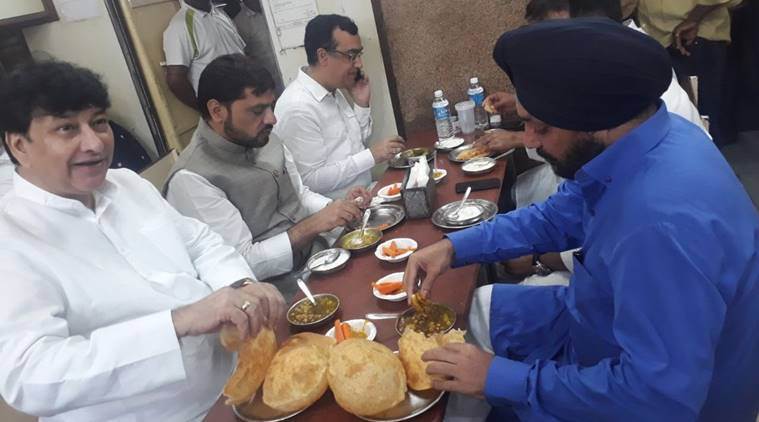 Such was the media blitz over Congressi chhole bature, that the grapevine says that the ruling party’s counter-fasters were strictly instructed not to be seen or photographed eating in advance.
Such was the media blitz over Congressi chhole bature, that the grapevine says that the ruling party’s counter-fasters were strictly instructed not to be seen or photographed eating in advance.
Early this week, television news exhibited an unbridled appetite for chhole bature, which Congress leaders fortified themselves with before a bantamweight fast, which was really a very short weight loss programme. Channels followed the non-story breathlessly, at the expense of sobering issues like the show of Dalit strength and the news of horrendous rapes and general impunity from two states. Readers of The Story of My Experiments with Truth (see facing page for a new, definitive edition) would be amazed at how efficiently the moral value of self-denial has been erased.
And the champion fasters who used to lend colour to Delhi’s Jantar Mantar until recently, might also have a thing or two to say about the better organised but no more meaningful fast of the BJP — scheduled for only the length of a working day. The poor, who are inured to keeping involuntary fasts every day, would have a thing or three to say about that, if they were called to TV panels. Such was the media blitz over Congressi chhole bature, that the grapevine says that the ruling party’s counter-fasters were strictly instructed not to be seen or photographed eating in advance. But the point at issue was just some chhole, not a banquet. A sign visible in pictures of the leaders tucking in established the class of the meal: ‘Extra sabzi Rs 20.’ It’s just so ordinary, it makes you fed up. Republic TV was in good form: “Hotel owner confirms hosting Congress leaders before the fast.” Guess they missed the menu card.
But the government provided meatier non-news than chhole this week: the cock and bull story that eight government websites had been hacked and characters in Chinese, presumably saying something rude, had appeared on the Ministry of Defence website. Since the Chinese have hacked us incisively earlier, the story raised respiratory rates, probes were instituted and officials and ministers hustled and bustled. The National Informatics Centre (NIC), which maintains the government’s websites, attributed it to a “hardware” problem and ruled out hacking.
Website developers who saw the error pages which downed government sites were showing, which included the alleged Chinese graffiti, would have known what it was. The answer is so silly that it should be explained. The graffiti is the kanji character for ‘Zen’. Zen is the name of the most popular starter theme for the Drupal content management system. NIC’s choice of Drupal is sound, since it is a secure system. But it has an annoying habit of downing the portcullis if the PHP memory limit set on the server is exceeded.
This can happen when a new module or theme is loaded, or even a routine update which uses more memory than the earlier version. Then Drupal shows only a maintenance page, and if the maintainers have been lazy and not branded it with, say, the logo of the Ministry of Defence, then it shows the starter theme logo, with the kanji characters that spell ‘Zen’. Ministers are spooked and a media frenzy follows. But one can appreciate the pain under which NIC claimed it was a “hardware” problem. They were ducking the horror of having to explain an IT issue to ministers who are hot on information but almost perfectly ignorant about technology.
No information was lost in translation in the extraordinary footage coming out of Chennai on Thursday, where Narendra Modi addressed the DefExpo, apart from other events. The camera’s focus was on black-clad protesters who had climbed onto a hoarding at Meenambakkam over the age-old Cauvery waters issue, but the most interesting footage was from the back of a truck, where policemen and security personnel were bursting black balloons. Pop, pop, pop went the balloons, which were to have been released to meet the prime minister’s helicopter. It isn’t often that a prime minister has to take a chopper not to evade terrorists, but public action. The Tamils have provided reassurance that India is in no danger of dreary homogeneity.
Overseas, the media has gone ape over the four-inch-thick “booster seat” that Facebook chief Mark Zuckerberg sat on, to appear taller and more commanding than his very average height, in a five-hour Congressional hearing over the Cambridge Analytica scandal. A booster seat is an automobile safety seat for children. The images of the seat first appeared on social media, but were enthusiastically adopted by the mainstream, with headlines asking Zuckerberg to grow up, and so on. No harm in having a little fun at his expense, because that’s all we’re going to get from this whole process. This is not the first time that Facebook has screwed up, wept and really not cared. And every time, its user base has shown no sign of shrinking.